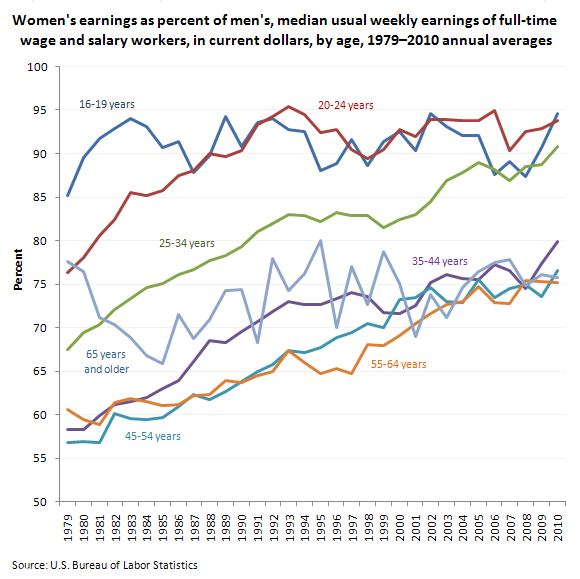July 22, 2011 (The Editor’s Desk is updated each business day.)
Women's earnings, 1979–2010
Between 1979 and 2010, the earnings gap between women and men narrowed for most age groups. Over that same period, at each level of education, women aged 25 years and older have also fared better with respect to earnings growth than men of similar age.
The women's-to-men's earnings ratio among 25- to 34-year-olds rose from 68 percent in 1979 to 91 percent in 2010, and the ratio for 45- to 54-year-olds increased from 57 percent to 77 percent.

[Chart data]
From 1979 to 2010, the long-term trends for teenagers and for workers age 65 and older fluctuated, but have essentially remained flat.
Although both women and men without a high school diploma have experienced declines in inflation-adjusted earnings from 1979 to 2010, the drop for women was significantly less than that for men: a 9-percent drop for women as opposed to a 31-percent drop for men.

[Chart data]
From 1979 to 2010, on an inflation-adjusted basis, earnings for women with a college degree have increased by 33 percent, while those of male college graduates have risen by 20 percent.
These data are from the Current Population Survey. Earnings data in this article are median usual weekly earnings of full-time wage and salary workers. To learn more, see "Highlights of Women's Earnings in 2010” BLS Report 1031 (PDF).
Related TED articles
Earnings and wages |
Men |
Women
Of interest
Spotlight on Statistics: National Hispanic Heritage Month
In this Spotlight, we take a look at the Hispanic labor force—including labor force participation, employment and unemployment, educational attainment, geographic location, country of birth, earnings, consumer expenditures, time use, workplace injuries, and employment projections.
Read more »

